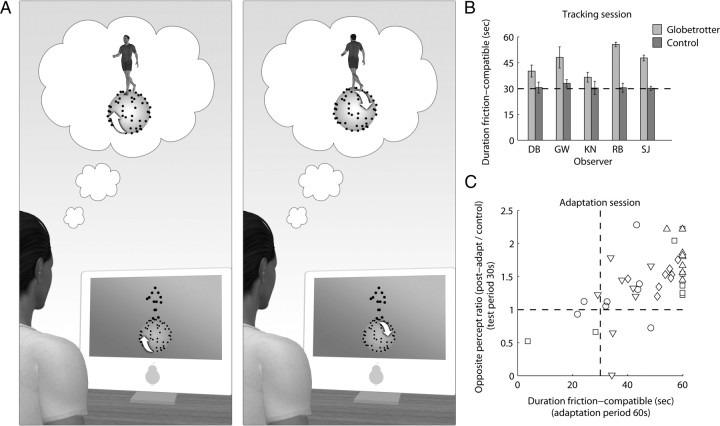Figure 7.
Context-disambiguation and adaptation. A, Locating the bistable PL walker on top of a stereo-defined, rotating globe created conditions that promoted stabilization of the bistable walker's perceived direction toward the friction-compatible percept. In the actual experiment, observers viewed the disparity-free walker and stereo globe through a mirror stereoscope; stimuli were presented as white dots on a gray background. B, Mean friction-compatible durations for globetrotter trials and randomly matched control trials (static globe) in the tracking session (see Materials and Methods). The bars represent the mean of eight 60 s tracking trials. With the moving stereo globe, observers (n = 5) experienced the friction-compatible percept for significantly longer durations than in control trials (t(4) = 4.5; p < 0.05). The horizontal dashed line indicates an equal total duration for friction-compatible/incompatible percepts. Error bars represent ±1 SE. C, In the adaptation session, observers completed 60 s tracking periods, which were immediately followed by 30 s tracking of the bistable walker alone. Control trials consisted of adaptation to the stereo globe alone, followed by 30 s test with the bistable walker. For each trial, the x-axis depicts the total time during the adapt period (60 s) in which the bistable walker was perceived in the friction-compatible mode; on the y-axis, a ratio measure is given, calculated as the total time in which the opposite percept was perceived during the 30 s test period divided by the corresponding measure from the control trials. This ratio measure controls for the possibility that adaptation resulted from stereo signals provided by the globe, as well as ensuring a pure measure of adaptation free of individual observer biases (e.g., observer DB experienced prolonged dominance of frontward walking in many trials). The vertical dashed line indicates an equal total duration for friction-compatible/incompatible percepts during the 60 s adapt period; the horizontal dashed line indicates a postadapt/control ratio of 1 for the test period (i.e., no adaptation).

